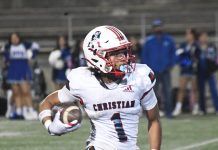The Gillespie Field hanger housing Air Group One in El Cajon was a fitting location to hear from Nelson Robinson, who was the invited speaker at the monthly BBQ. He shared a mixture of personal experiences with, and the lore and history of, the Tuskegee Airmen. During an interview prior to his comments to the general group, a linkage to San Diego State University came up.
The Gillespie Field hanger housing Air Group One in El Cajon was a fitting location to hear from Nelson Robinson, who was the invited speaker at the monthly BBQ. He shared a mixture of personal experiences with, and the lore and history of, the Tuskegee Airmen. During an interview prior to his comments to the general group, a linkage to San Diego State University came up.
Perhaps no other group of warriors from World War II (and immediately thereafter) is so easily recognized by multiple names: Tuskegee Airmen, the Fighting 99th, and the Red Tails. Similarly, perhaps no other story out of World War II evokes so much discussion and reflection today, in part because of the Jim Crow laws that existed at the time through many parts of the nation, racially segregating our military forces.
The first African-American pilots were educated at Tuskegee University and trained at Tuskegee Airfield, hence becoming known as the Tuskegee Airmen, the term encompassing pilots, navigators, bombardiers, mechanics, crew chiefs, and support personnel. Units and commands were all black, as were their bases. The 99th Pursuit Squadron, later the 99th Fighter Squadron, was the first all-black flying unit and deployed overseas in 1943, first to North Africa. It became known as the Fighting 99th. As more pilots were trained, the 332nd Fighter Group became the first all-black fighter group comprised of four all-black fighter squadrons. The crews painted the tails of their aircraft a distinguishing red, leading them to become known as the Red Tails. (This color scheme was carried on through the succession of aircraft the units flew, with the uniquely painted P-51 Mustangs becoming the aircraft most associated with the nickname.) Their mission, performed from various locations in North Africa and Europe during the war, was escorting bombers. But it was about an individual Tuskegee Airman, the Fighting 99th, and the Red Tails that the audience would hear.
After the Pledge of Allegiance and prior to beginning his comments, Robinson was presented a Certificate by Ms. Julie-Ann Softley, an intern from State Senator Joel Anderson’s office. Shortly after beginning his comments, Robinson needed to pause, due to the noise of a taxing aircraft. It seemed rather appropriate, all things considered. Robinson then went on to share some World War II lore and history of the Tuskegee Airmen.
It was after the end of World War II that, at age 17, Robinson joined the U. S. Army Air Force, at a time when units were still fully segregated. He had previously been in the Civil Air Patrol, explaining that he liked airplanes and was “tired of tying knots in the Boy Scouts.” After enlisting, he was assigned to a class of all-black aircraft mechanics and subsequently to a squadron at an all-black base.
He was sent overseas to Naha, Okinawa in Japan and assigned to the 4th Fighter Squadron to work as an Assistant Crew Chief for a P-61 Black Widow aircraft. These aircraft were soon replaced by twin engine Mustang Night Fighters. Of his time in uniform, he spoke of working on more aircraft, reciprocating and jet engines, trainers, cargo, fighters, and bombers, than anyone he knows. This, according to Robinson, included flying as crew chief on a cargo aircraft transporting an atomic bomb. Overall, he served as mechanic, crew chief, and flight engineer on B-26s, B-29s, and on B-25s during combat in Korea. He also noted that President Truman directed the integration of the Armed Forces in 1948, but that the all-black units did not break up until 1949.
Once, when Robinson was on a B-25 training flight, Robinson said they had a “hard landing” as they came into the airfield. It was so hard, he said, that the right landing gear wheel came off. Subsequently, the hydraulic fluid caught fire. As the pilot came around again and landed without the right landing gear wheel, their aircraft touched down and then swung around 180 degrees. Robinson directed the co-pilot and pilot to exit the aircraft over the nose, rather than normally through the hatch located in the belly of the aircraft, because of the risk of the fire entering the aircraft if that hatch were opened, which would have likely caused the aircraft to explode. Once out of the aircraft, he directed the firefighters where to attack the fire, saving the aircraft.
Robinson, full of tales from WWII, spoke of one mission of the Fighting 99th, involving a battle damaged bomber attempting to fly back to base after a mission over Germany. One of the important tasks assigned to the 99th Pursuit Squadron was escorting damaged bombers back to base, preventing German aircraft from shooting them down. As Robinson told it, the pilot of the damaged bomber radioed out, “Mayday. Mayday,” and a pilot from the 99th radioed back, “Boss Man, you don’t need to worry. Take it easy.” After the German aircraft had been chased away, the bomber pilot came up on the radio again. Once more the pilot from the 99th radioed, “Take it easy.” In the end, the Red Tail pilots escorted the bomber safely back to base.
Not all planes made it back safely, of course. Robinson also told of a Red Tail pilot who was shot down and captured by the Germans. According to Robinson, the commander of the German POW camp brought the pilot into his office, showed him Tuskegee training materials, said they had been waiting for a member of the Red Tails. The commander offered him a drink, and “treated him as an officer and gentleman, treating him better than he was treated back in America.”
When asked to name the most important part of his time in uniform, Robinson immediately declared, “School.” Having been raised by his widowed mother, he did not have a great interest in education until after entering the service. “I was made to study,” he stated, a point illustrated by his AB, BA, and MBA degrees.
Robinson said the youth of America today can learn a lot from the Tuskegee Airmen.
“Persevere,” he said. “Set goals. Focus
Robinson said his time with the Tuskegee Airmen was a paramount experience in his life.
“It instilled a higher degree, a higher level of confidence in myself,” said Robinson. “I went on to accomplish many things: Vice President of San Diego Business Resource Center, Deputy Director of Business Development Center at San Diego State University Foundation, earning three degrees and becoming a licensed civilian pilot.”
Ending his rendition of the above, Tuskegee Airman Mr. Nelson Robinson accepted the standing ovation from those gathered in the Air Group One hanger.
(Note: The Tuskegee Airmen Inc., General B. O. Davis, Jr. Chapter is hosting the Tuskegee Airmen Memorial Luncheon on Thursday March 22, 2018 at the Veterans Museum in Balboa Park. For more info contact tukegeesandiego@gmail.com.)
To learn about other events, including Youth Aviation Day on 7 April and Warbird Expo on 14 April, check out Air Group One’s website (https://ag1caf.org/).














